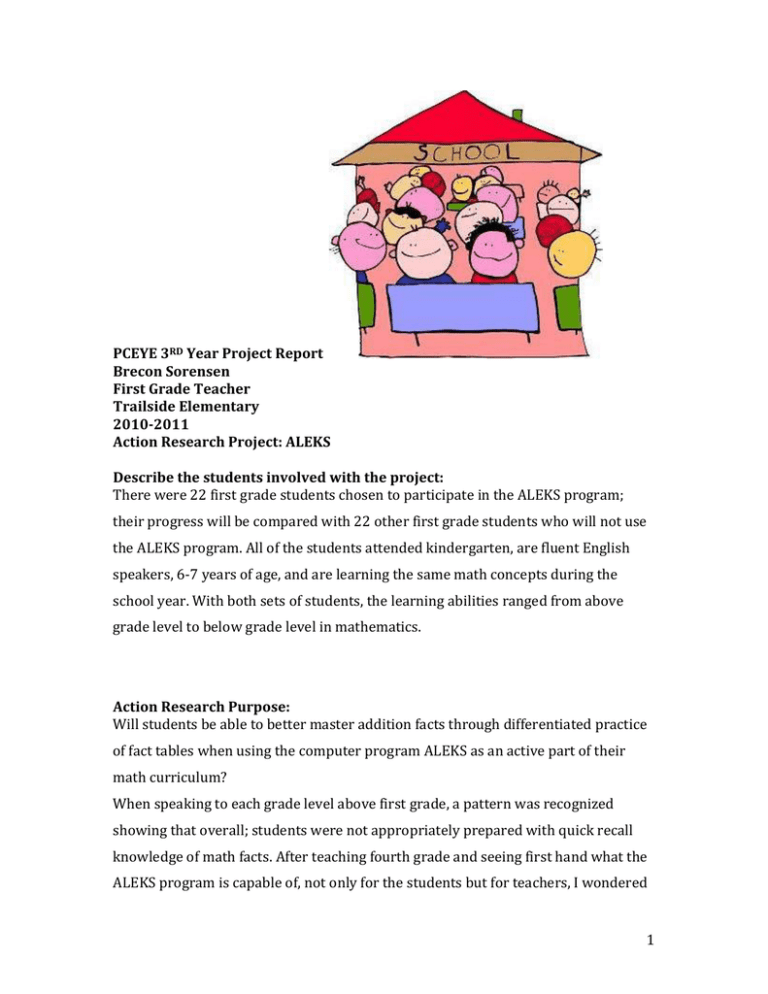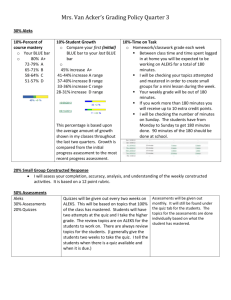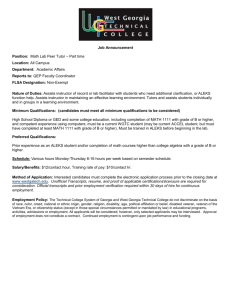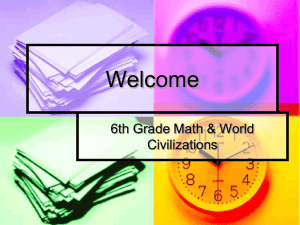PCEYE 3RD Year Project Report Brecon Sorensen First Grade
advertisement

PCEYE 3RD Year Project Report Brecon Sorensen First Grade Teacher Trailside Elementary 2010-2011 Action Research Project: ALEKS Describe the students involved with the project: There were 22 first grade students chosen to participate in the ALEKS program; their progress will be compared with 22 other first grade students who will not use the ALEKS program. All of the students attended kindergarten, are fluent English speakers, 6-7 years of age, and are learning the same math concepts during the school year. With both sets of students, the learning abilities ranged from above grade level to below grade level in mathematics. Action Research Purpose: Will students be able to better master addition facts through differentiated practice of fact tables when using the computer program ALEKS as an active part of their math curriculum? When speaking to each grade level above first grade, a pattern was recognized showing that overall; students were not appropriately prepared with quick recall knowledge of math facts. After teaching fourth grade and seeing first hand what the ALEKS program is capable of, not only for the students but for teachers, I wondered 1 how the “quick tables” portion of the program would work for the younger grades in mastering the required math facts. At five dollars per student our school decided to spend some of its funds to supply “quick tables” for the second grade, third grade and my first grade class. Most of the reading that I did in preparation for this project talked about the growing attraction to electronics and how children can combine the technology they crave while still learning and performing with excellence in the academic part of their life. This is also a pattern I found when speaking with the students. Computers are thrilling to them and getting time on them not only has helped them practice math facts that are necessary in the mathematical learning process but the students are also getting exposure to computers. These computer skills will be used throughout their educational career. When collaborating with our technology teacher, we decided that our main concern with this idea was that the students would not be able to get the information into the computer quick enough or that the program would not be easy enough for them to use. We went for it anyway to see if it was doable or if the frustration level would be too high. To our pleasant surprise, the students did remarkably well and due to the way the program is set up for children, it was not long before my primary role was as an observer and supporter. Project set up, delivery, work, and adjustments in instructional practices: Our technology teacher set up each student with an account in the ALEKS program. Each student received a user name and password. The initial assessment of the program started with the students simply typing in numbers that appear on the screen. This is to get the students used to using the number keypad on the computer to increase speed and accuracy when typing and submitting information. Next, the students are shown a chart on their screen with all of the addition math facts that they are required to master before they can move on to subtraction. The student then sees a series of problems that are shown one at a time. The goal is for the student to type in the answer and press return before ten seconds are up. If the student does this correctly, another problem shows up on the screen; if a student 2 does this incorrectly or takes longer than ten seconds, the right answer is shown and that problem will continue to show up until they answer it correctly. After a student has mastered 20% of the addition problems, they are transferred to a screen that allows them to play a game. Every 20% gain in mastering facts brings a new game. The games are also opportunities to practice facts. Clicking on the correct answer to an addition problem is how you advance during the game. Once a student has reached 100%, they are transferred to the subtraction “quick tables” and follow a similar process. At this point the program will ask to review addition from time to time to check for retention. The 22 students who worked with the ALEKS program were given access twice a week for 15 minutes. They were supervised by the teacher and encouraged to keep focused on their computer. The most helpful part of this program is that the students are able to work at their own pace and their own ability level. This way each student is taking responsibility for their own progress and the teacher can easily see who is struggling and who is finding quick success. From time to time the students need to be reminded to stay on task but overall they took on the challenge of this program with ease. They loved earning the games and watching as the personalized progress chart went up during each session. Some of the changes that I made during this project involved discussing individually with students how they were feeling about the program. Students who were obviously frustrated were given some other options. They could do ALEKS for a shorter time during our sessions, or they could pick one day a week to do it and the other day they would still work on math but not in this particular program. I did not want anyone to give up completely, but I did want him/her to have options that would stay with our purpose but not make any one student feel unsuccessful. Data and Results: Data I: Anecdotal Throughout this process I have been taking documentation on student progresshow they acted and reacted, and comments that they have made about ALEKS. 3 These first graders started ALEKS at the end of October and will continue using it through the end of the year. When re-reading my notes some of the patterns that I noticed were that overall students had a positive reaction to the program. As expected, students that were focusing more in class, practicing facts at home, and taking full advantage of their time on the program had the easier experience and therefore it was more positive and fulfilling. Students who have a harder time understanding new math concepts and spent time unfocused on their work had more problems with the program. It was clear that the student’s individual maturity level played a part. Many of these students, when asked about the program, said they liked it but would like to do it when they are older because it was a bit overwhelming for them. Everyone else seems challenged by the program and also competed with themselves to beat the high scores on the games and see how much progress they could make in a day or a week. It was impressive watching the selfmotivation, and the transfer of knowledge to the classroom. Data II: 22 vs. 22 Three-Minute Timings/ Everyday Math Assessment All students were learning and practicing addition skills from October through the time that these timed tests were administrated. This gave the students 3-4 months of practice before they were tested. The two timed tests were given at the beginning and the end of March with a final assessment given in April. Looking at the results of two 3-minute timings (that were given to the chosen students for this project,) the students practicing math facts on ALEKS started out with 47% accuracy compared to the students who did not use ALEKS with 33% accuracy. The second timing shows progress for both groups. The students who did not use the program increased their scores by 13% averaging 46% accuracy. The ALEKS group increased 5% averaging 52% accuracy. Although the non-ALEKS students had more of an improvement, their percentage on the second timing was still not as high as the ALEKS students on their first timing. On the Everyday Math Assessment the students who used ALEKS had an average of 95% on the ten questions chosen to determine whether transference had occurred. 4 These questions consisted of 7 addition problems and 3 subtraction problems. The non-ALEKS students had 87% accuracy. Data III: ALEKS Progress Reports: The ALEKS report shows individual student’s progress (see attached). This document shows where the students tested when they first began in blue, the progress they have made with the program in green, and what they still need to achieve in yellow. Everyone made progress. It also shows the time each student has spent on the program and what activities were done on what day. Nine out of the twenty-two students using ALEKS have impressively passed the entire addition section of quick tables at this point. Room for Improvement: changes, suggestions, and new questions: The greatest part of this program is the ability to differentiate for the students. Changes that I would make would be to personalize the program even more, excelling the program for students that are ready and capable of handling, not only the curriculum but also, the use of technology. For the students who need a more narrow focus in math, I would choose “quick tables” for them to hone a particular skill as extra practice. For the struggling mathematicians, I would see what they were capable of and use the program temporarily to give them exposure without crossing the unnecessary frustration lines. First grade did seem a little young to use this program, but everyone was successful regardless of attitude towards it. The students loved getting time in the computer lab, and exposure to the keyboard and mouse. These skills will help all of them in the school years to come. SIOP Connection: Practice and Application: Students were able to use information taught in class and the ALEKS program to practice calculating and understanding addition facts. They then would take the time they practiced and apply it to their daily classroom work. 5 Assessment and Review: Not only does this program help the teacher effectively assess each individual student and monitor the progress within ALEKS, but the students are always aware of their own progress, what they need to practice and how to master each phase of the program. Students are given retention tests throughout the program to review information learned and to help ensure that the information transfers. In Conclusion: The ALEKS “quick tables” are another way to motivate students to learn and master math facts. The differentiation component is the appeal to this particular math program. The control and responsibility it gives the student are additional benefits. Gathering student data is essential to successful student learning. The ALEKS program makes this accessible and easy to understand for teachers, students, and parents alike. Keeping the ALEKS program in Park City Schools will be beneficial for everyone involved. 6



